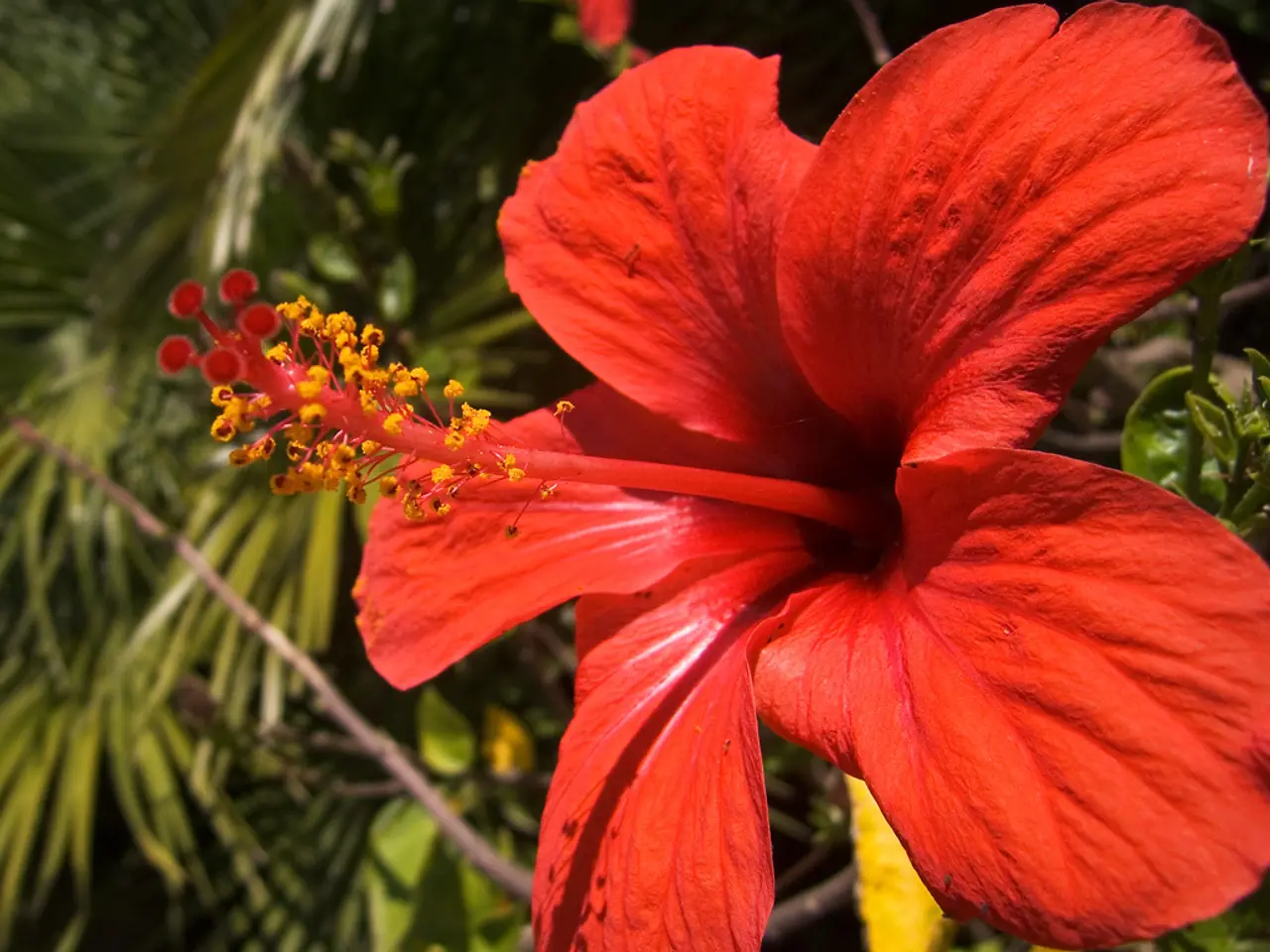Keep an Eye out for Regular Hibiscus Issues: A Look at 5 Prevalent Diseases
Hibiscus plants, known for their vibrant colours and tropical vibe, can sometimes fall victim to various diseases and pests. In this article, we will discuss common fungal infections, pest infestations, and environmental stress that affect hibiscus plants, along with identification, treatment, and prevention methods.
Common Diseases and Identification
Fungal leaf spots and black spots are among the most common issues hibiscus plants face. Look for dark spots on leaves that may be caused by fungal pathogens. Black spots often appear with lesions or mushy spots near the crown; advanced stages may show cobweb-like fungal growth on lower leaves [1][2].
Powdery mildew is another fungal disease that manifests as white powdery spots on leaves, particularly on the upper surfaces. This disease thrives in humid but poorly ventilated conditions [2][5].
Botrytis blight, also known as gray mold, affects flower buds, distorting growth and covering each with a grayish fuzz. It is most prevalent under cool, wet conditions [5].
Yellowing leaves may indicate water stress, temperature fluctuations, or pest damage rather than disease alone [4][5].
Common Pests Affecting Hibiscus
Aphids, small sap-sucking insects on leaf undersides and stems, cause leaf curling, yellowing, and potential disease vectoring. Spider mites thrive in dry environments, causing stippling damage on leaves and fine webs. Other pests like thrips, scale insects, whiteflies, and mealybugs can also infest hibiscus and stress the plant [5].
Treatment and Management
For fungal infections such as black spots, powdery mildew, and botrytis, remove and discard affected leaves to reduce inoculum. Use copper-based fungicides for black spot control and sulfur-based fungicides against powdery mildew [2]. Improving air circulation by pruning dense foliage helps prevent fungal diseases [2]. Avoid overhead watering to minimize leaf wetness [2].
Physically remove aphids using a strong water spray, then apply neem oil or insecticidal soap to suppress populations [2][4]. Increase humidity and regularly spray plants to discourage spider mites; insecticidal soap can also be effective [2]. Repeat treatments every 7-10 days as needed.
Regular inspection of plants is key to early detection and effective control of both diseases and pests. Using organic treatments like neem oil supports long-term plant health and reduces chemical dependence [2].
Prevention
Prevention of Hibiscus Leaf Spot includes ensuring new plants or cuttings are disease-free and good watering and garden sanitation techniques. Prevention of Botrytis Blight includes allowing for adequate airflow between plants and deadheading, or the removal of faded flowers [2]. All debris should be removed from the garden and disposed of to prevent dieback disease reintroduction [2].
Maintain balanced watering to avoid stress (not too wet or dry), provide appropriate sunlight (full or partial sun), enrich soil with organic matter, and prune to keep plant healthy and compact [4][5].
In summary, monitor hibiscus plants for spots, powdery residue, and pests; remove affected parts promptly; apply targeted fungicides and insecticides such as copper fungicides and neem oil; and ensure optimal growing conditions with proper watering, sunlight, and ventilation to prevent and control common hibiscus diseases [1][2][4][5].
Gardeners should keep a keen eye out for common hibiscus diseases and their symptoms, as early detection and treatment can significantly improve the plant's chances of recovery. With proper care and attention, hibiscus plants can continue to bring their dazzling colours and tropical vibe to your garden.
References:
[1] University of Florida IFAS Extension. (2021). Hibiscus Leaf Spot. [Online] Available at: https://edis.ifas.ufl.edu/pdffiles/PP/PP34100.pdf
[2] North Carolina State University. (2020). Hibiscus Leaf Spot. [Online] Available at: https://content.ces.ncsu.edu/hibiscus-leaf-spot
[3] University of California Agriculture and Natural Resources. (2021). Hibiscus Leaf Spot. [Online] Available at: https://ucanr.edu/sites/pestnote/files/314371.pdf
[4] University of Florida IFAS Extension. (2021). Hibiscus Wilt. [Online] Available at: https://edis.ifas.ufl.edu/pdffiles/PP/PP34101.pdf
[5] University of Florida IFAS Extension. (2021). Common Hibiscus Plant Problems. [Online] Available at: https://edis.ifas.ufl.edu/pdffiles/HS/HS111200.pdf
- To promote overall wellness of hibiscus plants, consider adopting healthy lifestyle choices such as maintaining a balanced nutrition plan that includes adequate water and proper sun exposure, akin to our own dietary needs.
- If you are seeking to create a more serene and peaceful environment within your home, consider incorporating gardening in your home-and-garden lifestyle, with hibiscus plants adding vibrant colours and a tropical vibe, similar to the way fitness-and-exercise boosts our mental health and well-being.
- In matching the hibiscus plants' needs with your gardening approach, be mindful of optimal soil quality, ensuring it is enriched with organic matter; this reflects parallels seen in improving health via a nutritious diet.




